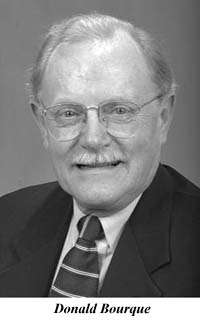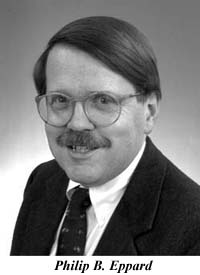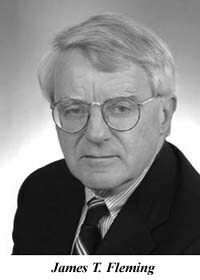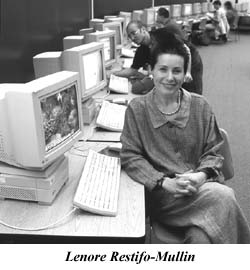Bourque, Eppard, Fleming Named Deans
By Christine Hanson McKnight

Three long-time members of the University community have become deans, it was announced by Judy L. Genshaft, Provost and Vice President for Academic Affairs.
Donald Bourque has been named to serve as dean of the School of Business for a two-year term, Philip B. Eppard dean of the School of Information Science and Policy for a three-year tenure, and James T. Fleming dean of the School of Education for a two-year term. All three had previously held their posts on an interim basis.
Bourque, who had served as interim dean of the School of Business since July of 1994, joined the University as associate dean and professor of accounting in 1972. He received his M.B.A. and Ph.D. from the University of Washington, and has focused his research on topics of accounting, management, information systems, cost analysis, and business strategy. He has also been active in designing and promoting executive development programs in the U.S. and abroad.
“As interim dean, Dr. Bourque has demonstrated he has the experience, energy, and commitment to assume this major and important responsibility,” Provost Genshaft said. “I am pleased that he has expressed interest in continuing the assignment for the 1997-99 term.”
 Eppard, who has served as interim dean since September of 1995, joined the
University in 1988 and has worked to develop a specialization in archives
management within the School of Information Science and Policy. He holds a
Ph.D. in American civilization from Brown University and an M.S. in library
and information science from Simmons College, and is a specialist in
archives, manuscripts, rare books, and contemporary publishing. He is
currently editor of American Archivist, the quarterly journal of the
Society of American Archivists.
Eppard, who has served as interim dean since September of 1995, joined the
University in 1988 and has worked to develop a specialization in archives
management within the School of Information Science and Policy. He holds a
Ph.D. in American civilization from Brown University and an M.S. in library
and information science from Simmons College, and is a specialist in
archives, manuscripts, rare books, and contemporary publishing. He is
currently editor of American Archivist, the quarterly journal of the
Society of American Archivists.
“Dr. Eppard’s continued leadership will be instrumental in strengthening the School of Information Science and Policy’s undergraduate and master’s programs,” Provost Genshaft said. “We look forward to the new direction and vision he will provide to the School.”
 Fleming, who served as interim dean of the School of Education since August
of 1995, came to Albany in 1969 as an associate professor of reading. He
was promoted to full professor in 1974, served as chair of the Department
of Reading from 1976 to 1981, and as associate dean of the School of
Education from 1982 to 1995. He earned his doctorate from Harvard
University and has taught at all levels of public schooling, from
elementary through the doctoral level. His primary scholarly interests are
in the psycholinguistic and sociolinguistic aspects of reading and learning
to read and write. He was named the University’s Collins Fellow in 1994 and
also received the Excellence in Academic Service Award in 1993 and the J.
Ralph Tibbetts Award from the School of Education in 1990.
Fleming, who served as interim dean of the School of Education since August
of 1995, came to Albany in 1969 as an associate professor of reading. He
was promoted to full professor in 1974, served as chair of the Department
of Reading from 1976 to 1981, and as associate dean of the School of
Education from 1982 to 1995. He earned his doctorate from Harvard
University and has taught at all levels of public schooling, from
elementary through the doctoral level. His primary scholarly interests are
in the psycholinguistic and sociolinguistic aspects of reading and learning
to read and write. He was named the University’s Collins Fellow in 1994 and
also received the Excellence in Academic Service Award in 1993 and the J.
Ralph Tibbetts Award from the School of Education in 1990.
“Dr. Fleming is an excellent teacher, scholar and mentor and an exemplary University and professional citizen,” Provost Genshaft said. “His leadership has been instrumental in sustaining the School over the past two years, and we are very pleased that he has agreed to continue to lead the School over the next two years of its development.”
Bourque’s and Fleming’s two-year terms began Sept. 1, while Eppard’s three-year appointment began July 1.
Sigma Xi to Shine Spotlight on Great Science
by Vinny RedaOne of the latest and very likely most far-reaching discoveries in the history of science will be the subject of two events that kick off the University at Albany and Sigma Xi Public Lecture Series on Scientific Research, a program that Sigma Xi’s local president says will bring a heightened awareness of current science to the Capital Region and highlight the outstanding scientific community now part of the University faculty.
 Lenore Restifo-Mullin of the Department of Computer Science is no doubt one
of those standouts, being one of just 30 Presidential Faculty Fellows in
the U.S. in 1993, as chosen by the National Science Foundation. She is now
president of the University at Albany Sigma Xi chapter — which includes
scientists from the University, the state’s Wadsworth Center, Albany
Medical Center, and the College of St. Rose — and she says the two lectures
dealing with the science and ethics of cloning should be fascinating and of
importance to every citizen.
Lenore Restifo-Mullin of the Department of Computer Science is no doubt one
of those standouts, being one of just 30 Presidential Faculty Fellows in
the U.S. in 1993, as chosen by the National Science Foundation. She is now
president of the University at Albany Sigma Xi chapter — which includes
scientists from the University, the state’s Wadsworth Center, Albany
Medical Center, and the College of St. Rose — and she says the two lectures
dealing with the science and ethics of cloning should be fascinating and of
importance to every citizen.
Of the initial event, “The Science of Cloning,” on Oct. 9, Mullin said, “The announcement this year of a cloned sheep received a good deal of media attention and certainly captured the public imagination. It also evoked all kinds of futuristic scenarios.
“But although this discovery seemed to capture society by surprise, it was actually preceded by a series of incremental scientific breakthroughs from which the cloning technology developed. That’s what Pam Swiatek, who is a research scientist with the Wadsworth laboratories will discuss.”
On Nov. 13, John Balint, professor of medicine and director of the Center for Medical Ethics at Albany Medical College, will discuss the range of ethical questions arising from these new technologies — such as, when does human life begin?, what do we do with these spare embryos?, and genetics versus genomics or eugenics. “I’m sure there will be plenty of opinions and other participation from the audience,” said Mullin.
Both “The Science of Cloning” with Swiatek and “The Ethics of Cloning” with Balint take place at 8 p.m. in the Performing Arts Center, the locale for the final Sigma Xi event for this semester (although Mullin says the group may sponsor a Christmas-time science lecture for children), the all-day Dec. 2 Joseph Henry Bicentennial Conference, celebrating the 200th anniversary of the birth of the Albany-born pioneer in electromagnetism, whose name graces the campus physics building.
Lecturer for that event — which will be part of an region-wide commemoration of Henry — will be James A. Frank, a lecturer in “history of science” at the Royal Institution Centre for History of Science and Technology, Royal Institution, in London.
“We hope this series will highlight the science community we have here, as exemplified by Sigma Xi, which is the international honor society for scientists and engineers, — the Phi Beta Kappa of the profession” said Mullin. “More than 170 of its members have been Nobel Prize and Turing Award winners in computer science, including Albert Einstein, Linus Pawling, Alan Perlis and Richard Feynman.
“And one of those Turing Award winners in fact is a member of the computer science department here, Richard Stearns. I’m an NSF Presidential Fellow, and so is Caro-Beth Stewart in biology. So there are famous scientists here, and people should know about that. And other scientists should be encouraged to earn membership to Sigma Xi. Students too — they can become associate members, and that is one of the best ways possible to cultivate a scientific career.”
Mullin said she has a particular debt to the State University system, having received her first degree, in math education, from SUNY College at New Paltz. “If not for this system I could never be where I am today. So I want the public to know who we are at this institution, and what we do, and how important what we do is in the world of science.”
Website for the series is http://www.cs.albany.edu/~sigmaxi
Untangling the Mystery of the Poly-Legged Frog
 Among the multitude of nature’s problems that human beings need feel guilty
over — scratch off tripedal frogs.
Among the multitude of nature’s problems that human beings need feel guilty
over — scratch off tripedal frogs.
Stanley K. Sessions, a Hartwick Col-lege biology professor, believes he has solved the mystery surrounding the recent discovery of deformities in the usually duo-web-footed amphibians, and it’s not chemical pollution.
Sessions will deliver a lecture on the topic at the University on Tuesday, Oct. 7, at 4:10 p.m. in Room 248 of the Biological Sciences Building. Free and open to the public, the talk is sponsored by the Department of Biological Sciences and its Biodiversity, Conservation and Policy Program.
Sessions is probably best known for his work on what causes deformities, such as additional limbs, in frogs. His research focuses on parasites as the cause for the deformities, rather than chemicals, and it has been featured in the media across the country, including the Washington Post, ABC’s “Nightline,” USA Today and CNN.
He will also be part of a Discovery Channel program in October, and the Boston Globe recently described his lab as emerging as the leader in studying natural causes of deformities in amphibians. He has also been a key presenter at several EPA conferences on the topic of deformed amphibians across the country.
Poly-legged frogs have been described in scientific literature since the last century, but the phenomenon has received renewed attention because of the large numbers of poly-legged varieties discovered last summer over much of the Northeast and Midwest, according to Margaret Stewart, director of the Biodiversity, Conservation and Policy Program.
“Some people have ‘jumped’ to the conclusion that the deformed frogs are caused by some form of chemical pollution, but so far, this has not been demonstrated,” said Stewart.
In 1990, Sessions published the results of his research showing that limb deformities, including multiple extra hind limbs, are caused by cysts of a parasitic flatworm, the trematode. In the past seven years, his parasite study has become the leading hypothesis to explain most deformities in natural populations of amphibians. Sessions is convinced his research removes chemical pollutants as a cause for any of the deformities.
Sessions presented his research results at an U.S. Environmental Protection Agency-sponsored conference earlier this month. “All of the multi-legged frogs that have been sent to me are infested with parasite cysts, which fits with what I’ve found previously,” Sessions said. He has also discovered a way to predict when and where an “epidemic” of multi-legged amphibians will occur, “which will be particularly important in endangered amphibian populations,” he said.
Most recently he has been analyzing a second category of deformities, frogs with missing limbs. “My students and I have completed our analysis of these frogs and we can now report that their limbs were lost after metamorphosis and so are not developmental defects. We have evidence that they were probably bitten off by a predator.”
Sessions, who came to Hartwick in 1989, teaches animal development and evolution.
Christine Hanson McKnight
